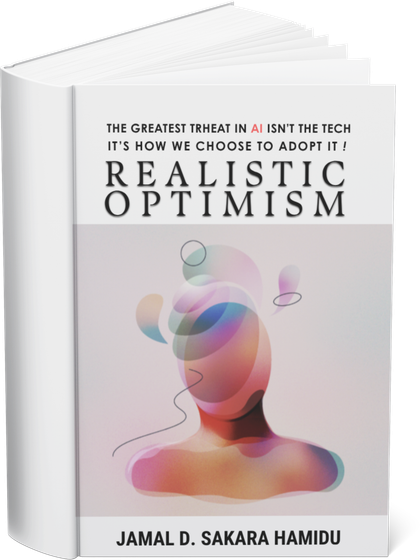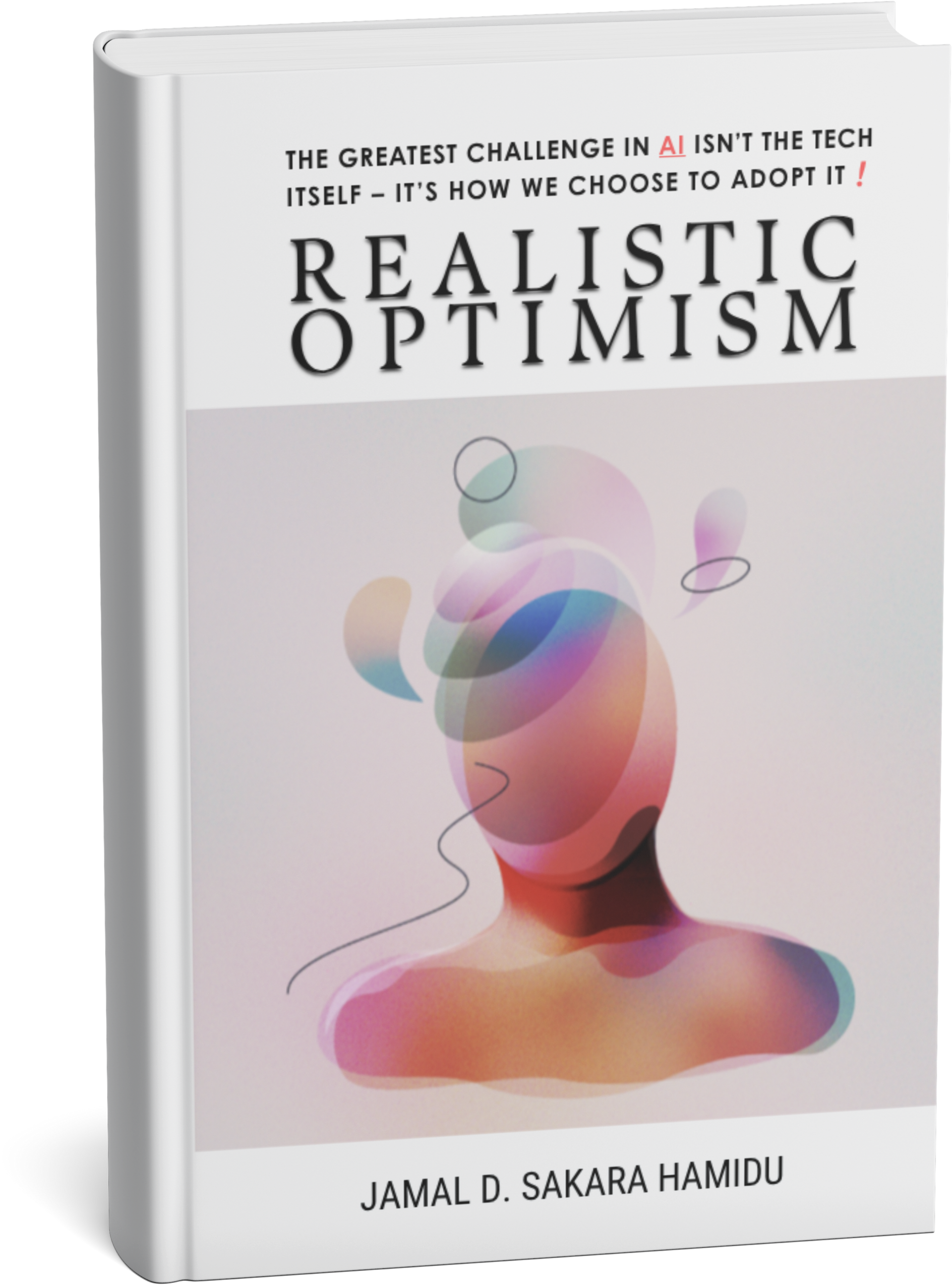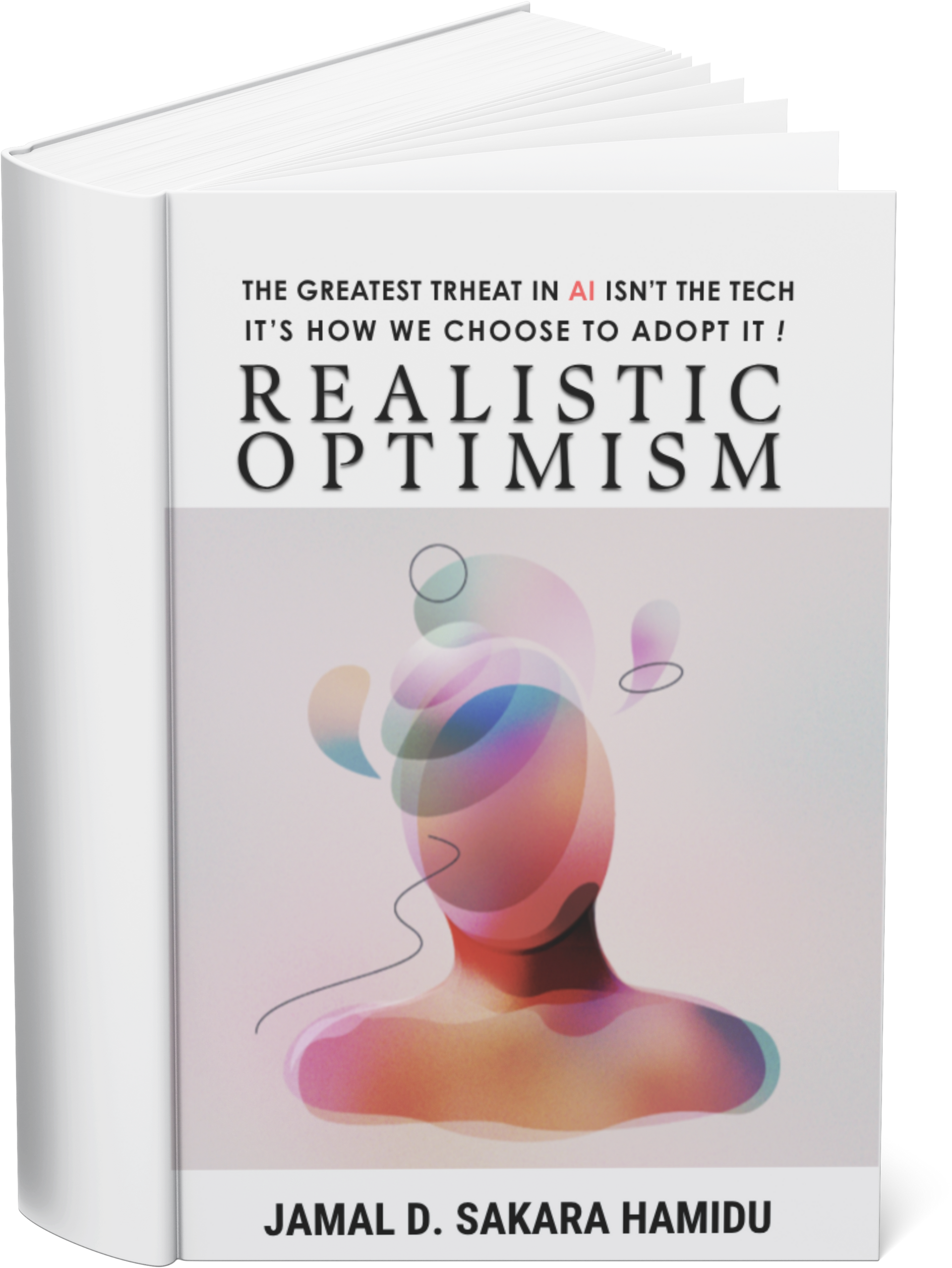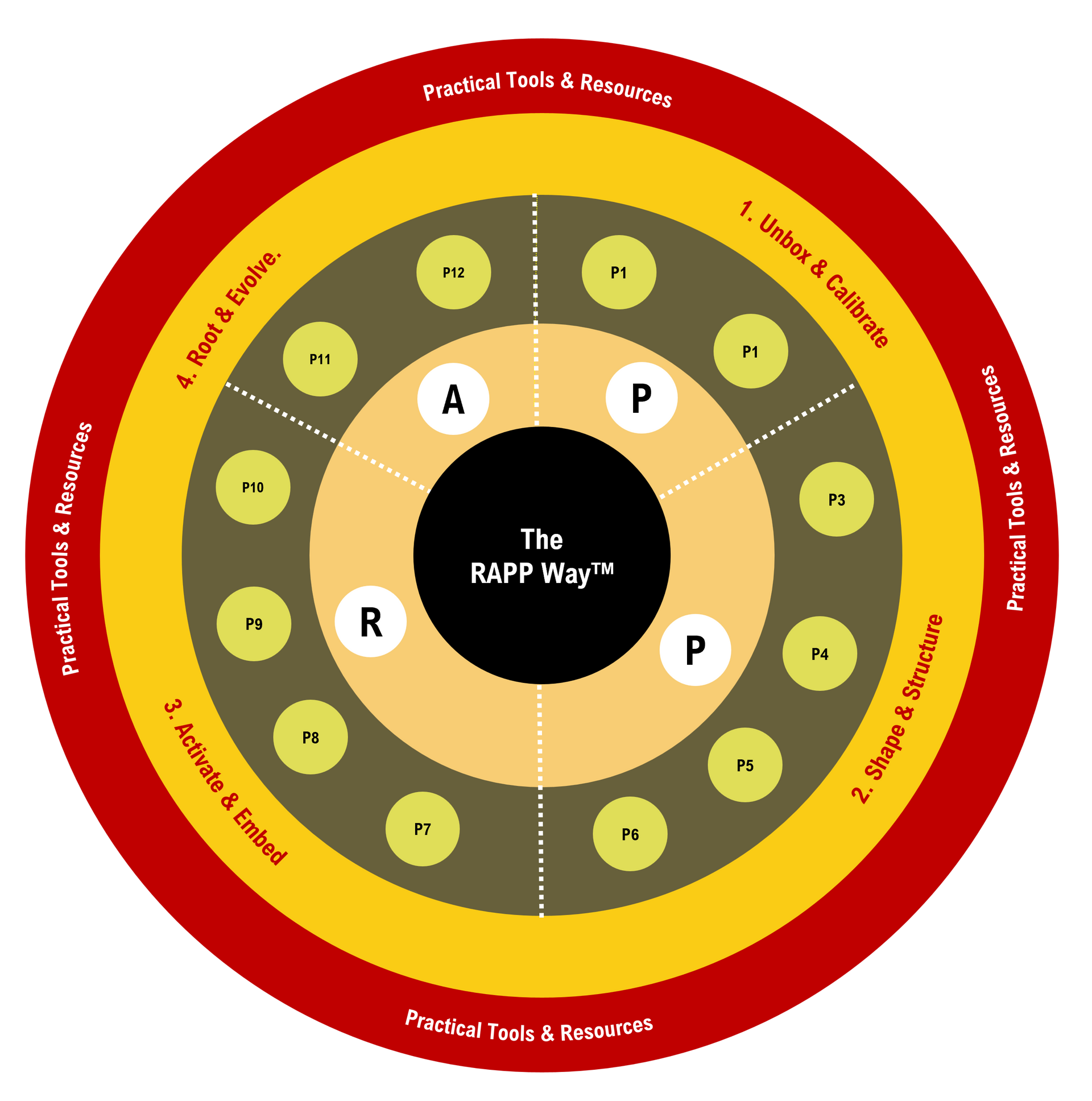
Realistic Optimism
What if the real threat in AI isn’t the technology itself—but the way we choose to adopt it.
Strategic Change Leader Jamal D. Sakara Hamidu explores this question by challenging the binary thinking that dominates today’s AI conversation—arguing for a more grounded, inclusive, and strategic path forward.
In Realistic Optimism, Jamal argues that beyond the utopian hype and dystopian fears lies a different kind of AI future—one as powerful as it is people-centred. He presents Realistic Optimism not as a middle ground, but as the only credible path forward for those committed to responsible adoption, inclusive design, and AI that delivers sustainable, long-term value.

Realistic Optimism
What if the real threat in AI isn’t the technology—but the way we choose to adopt it.
Strategic Change Leader Jamal D. Sakara Hamidu shares why he believes the greatest threat in AI isn’t the technology itself—but how we choose to adopt it.
In Realistic Optimism, Jamal argues that beyond the utopian hype and dystopian fears lies a different kind of AI future—one as powerful as it is people-centred. He presents Realistic Optimism not as a middle ground, but as the only credible path forward for those committed to responsible adoption, inclusive design, and AI that delivers sustainable, long-term value.
About the Book
Realistic Optimism
You don’t have to choose between innovation and integrity—Realistic Optimism shows you how.
In an age of accelerating technology, this book offers a strategic approach to AI adoption that places people and purpose at the centre of responsible transformation. While recognising the pressure to move fast, it confronts a deeper risk: not the technology itself, but how we choose to adopt it. It equips leaders with a framework to move forward with clarity—balancing speed with responsibility, and innovation with sustainability.
Imagine an AI journey that moves with urgency, not haste; stays accountable without stalling; includes by intention, not by exception; and listens deeply before it dares to lead. Grounded in enterprise transformation work—and shaped by experience at EY, Shell, AstraZeneca, Deutsche Bank, and beyond—Jamal D. Sakara Hamidu shows how organisations can adopt AI in ways that are culturally aware, ethically grounded, and built to last.
At the heart of the book is The RAPP Way™—a strategic change methodology anchored in four core philosophies: Responsible, Adaptive, People-Centred, and Purpose-Driven. Its execution engine, The RAPP Implementation Framework™, offers a clear, four-phase pathway for embedding AI sustainably across complex organisations—ensuring that transformation is not only effective, but enduring. Because in a future shaped by AI, how we choose to lead the change will matter more than the technology itself.

Slide title
Write your caption hereButton
Slide title
Write your caption hereButton
Slide title
Write your caption hereButton
Slide title
Write your caption hereButton
Slide title
Write your caption hereButton

THE GREATEST THREAT IN AI ISN'T THE TECHNOLOGY — IT'S HOW WE CHOOSE TO ADOPT IT!
About the Book
Realistic Optimism
You don’t have to choose between innovation and integrity—Realistic Optimism shows you how.
In an age of accelerating technology, this book offers a strategic approach to AI adoption that places people and purpose at the centre of responsible transformation. While recognising the pressure to move fast, it confronts a deeper risk: not the technology itself, but how we choose to adopt it. It equips leaders with a framework to move forward with clarity—balancing speed with responsibility, and innovation with sustainability.
Imagine an AI journey that moves with urgency, not haste; stays accountable without stalling; includes by intention, not by exception; and listens deeply before it dares to lead. Grounded in enterprise transformation work—and shaped by experience at EY, Shell, AstraZeneca, Deutsche Bank, and beyond—Jamal D. Sakara Hamidu shows how organisations can adopt AI in ways that are culturally aware, ethically grounded, and built to last.
At the heart of the book is The RAPP Way™—a strategic change methodology anchored in four core philosophies: Responsible, Adaptive, People-Centred, and Purpose-Driven. Its execution engine, The RAPP Implementation Framework™, offers a clear, four-phase pathway for embedding AI sustainably across complex organisations—ensuring that transformation is not only effective, but enduring. Because in a future shaped by AI, how we choose to lead the change will matter more than the technology itself.

Slide title
Write your caption hereButton
Slide title
Write your caption hereButton
Slide title
Write your caption hereButton
Slide title
Write your caption hereButton
Slide title
Write your caption hereButton
Slide title
Write your caption hereButton
Take Your First Steps
There’s plenty you can do while Realistic Optimism makes its way to print—explore, connect, and take your first steps today.
Take Your First Steps with
Realistic Optimism
There’s plenty you can do while Realistic Optimism makes its way to print—explore, connect, and take your first steps today.
Step inside the book.
Explore the book’s six-part journey—each section previewed to show how Realistic Optimism reshapes AI adoption from the ground up.
Experience The RAPP Way™
Take an interactive tour of The RAPP Way. Experience how its four building blocks integrate purpose, people, adaptability, and responsibility.
Explore the Book
Explore the book’s six-part journey—each section previewed to show how Realistic Optimism reshapes AI adoption from the ground up.
Experience The RAPP Way™
Take an interactive tour of The RAPP Way. Experience how its four building blocks integrate purpose, people, adaptability, and responsibility.
Step inside the Book
Explore the book’s six-part journey—each section previewed to show how Realistic Optimism reshapes AI adoption from the ground up.
Discover The RAPP Way™
Take an interactive tour of The RAPP Way. Experience how its four building blocks integrate purpose, people, adaptability, and responsibility.
Step inside the book
The book is organised in 6 Parts. Each part and the 13 chapters make up a compelling read.
Explore inside the book
The book is organised in 6 Parts. Each part and the 13 chapters make up a compelling read.
Realistic Optimism
Part 1 - The Journey
To navigate the future, we must first understand the past. AI’s journey has been marked by cycles of excitement and disillusionment—decades of breakthroughs followed by periods of stagnation, known as AI Winters. From its origins in academic theory to its rise as a global force transforming industries, AI has evolved in unpredictable ways.
Part One explores AI’s historical development and its profound societal impact, revealing the foundations upon which today’s AI adoption challenges and opportunities are built. Yet, while AI’s potential is undeniable, its widespread adoption is anything but straightforward.
- Chapter 1 – The Evolution of AI
- Chapter 2 - The Societal Impact of AI
Part 2 - The Barrier
Understanding AI’s history helps us recognise why its adoption has not been seamless. Despite its promise, organisations continue to struggle with integration—not due to lack of innovation, but because of deep-rooted cultural, structural, and ethical constraints.
Part Two uncovers the full landscape of barriers to responsible AI adoption. It begins with the visible external pressures—bias, regulation, and public scrutiny. It then turns inward, exposing the emotional toll of change on individuals and workforces. It adds a critical lens on design, revealing how exclusion isn’t accidental, but often built in from the start. And it closes by confronting the weight of outdated systems, fragmented ownership, and institutional inertia.
These are not isolated issues. They reinforce one another—ensuring that without a holistic approach, even the most well-intentioned AI strategy will falter. Yet challenges are not roadblocks—they are signals, pointing us to what must change.
That’s where Part Three begins: with the shift from insight to execution. It explores how organisations can move beyond awareness to build the capabilities, systems, and leadership models needed to make responsible AI adoption not just possible—but sustainable.
Chapter 3 - The Visible Fault Lines
Chapter 4 - The Emotional Cost of Change
Chapter 5 – The Illusion of Inclusion: The Case for Inclusive AI by Design
Chapter 6 - The Weight of the System
Part 3 - The Solution
If barriers highlight what holds AI adoption back, solutions illuminate the way forward.
Part Three introduces The RAPP Way™—a future-ready strategic change management methodology for responsible AI adoption, anchored in four guiding philosophies: Responsible, Adaptive, People-Centred, and Purpose-Driven. At its core is The RAPP Implementation Framework™—the execution engine of The RAPP Way™—which provides a structured, four-phased pathway for translating its philosophies and principles into practice.
By embedding AI within a strategic change model, businesses can move beyond isolated experiments to sustainable, value-driven adoption.
Chapter 7 – Introducing The RAPP Way™
Chapter 8 - The RAPP Implementation Framework™ – Putting The RAPP Way into Practice
While Part 3 identifies solutions, it is just the first step—true success depends on how effectively AI transforms organisations as you will discover later on in Part 4.
Part 4 - The Transformation
AI’s success should not be measured by its technical sophistication alone, but by the business transformation and value it creates.
Part 4 explores how AI acts as a catalyst for business transformation, driving innovation, efficiency, and new opportunities. It also provides a framework for measuring AI success, ensuring that organisations track not just traditional performance indicators (KPIs), but also behavioural and cultural shifts (KBIs) that signal deeper, long-term impact. Beyond measurement, AI adoption must be sustained, refined, and adapted as both technology and organisational needs evolve.
Chapter 9 - AI as a Catalyst for Business Transformation
Chapter 10 - Measuring AI Success
Part 5 - The Governance
Ensuring AI adoption is trustworthy, ethical, and sustainable requires governance that balances innovation with accountability. Governance is not just about compliance—it is about embedding policies, oversight mechanisms, and ethical standards that foster transparency, trust, and long-term sustainability.
Part Five examines external governance frameworks, including government regulations, adaptive models like regulatory sandboxes, and sector-specific policies, which set the legal and ethical parameters for AI adoption. It also explores internal governance, showing how organisations can embed ethical AI principles into strategy, culture, and decision-making to align with regulatory expectations while maintaining agility.
Governance must also be operationalised—this part explores how organisations move from policy to practical implementation, ensuring AI remains fair, explainable, and aligned with societal expectations. Ethical AI is not self-regulating—it requires structured oversight to deliver on its promise.
Chapter 11 - Policy and Governance Models for AI Adoption
Chapter 12 - Ethical AI and Governance in Practice
Part 6 - The Future
AI is not static—it’s a fast-moving force reshaping how industries operate, societies function, and leadership evolves.
Part Six, the concluding part, looks ahead, exploring the trends, governance shifts, and ethical challenges that will shape AI’s next chapter. It asks the core questions: How do we govern AI that acts on its own? What ethics should guide emotionally intelligent systems? Can trust survive in an age of synthetic content? How should organisations adapt to changing regulations? And what skills will tomorrow’s workforce need to succeed?
It also considers the path to Artificial General Intelligence (AGI)—a frontier rich with promise and risk. What choices must leaders make as AI begins to reason across senses? Can governance keep up with systems that outgrow narrow tasks? And how do we ensure AI drives equity, sustainability, and long-term value?
At the centre is one defining question: Will AI adoption lead to real transformation—or just another wave of hype? The answers will shape not just the future of technology, but the future of leadership.
Chapter 13 - Navigating the Future of AI Adoption
Realistic Optimism
Part 1 - The Journey
To navigate the future, we must first understand the past. AI’s journey has been marked by cycles of excitement and disillusionment—decades of breakthroughs followed by periods of stagnation, known as AI Winters. From its origins in academic theory to its rise as a global force transforming industries, AI has evolved in unpredictable ways.
Part One explores AI’s historical development and its profound societal impact, revealing the foundations upon which today’s AI adoption challenges and opportunities are built. Yet, while AI’s potential is undeniable, its widespread adoption is anything but straightforward.
Chapter 1 – The Evolution of AI
Chapter 2 - The Societal Impact of AI
Part 2 - The Barrier
Understanding AI’s history helps us recognise why its adoption has not been seamless. Despite its promise, organisations continue to struggle with integration—not due to lack of innovation, but because of deep-rooted cultural, structural, and ethical constraints.
Part Two uncovers the full landscape of barriers to responsible AI adoption. It begins with the visible external pressures—bias, regulation, and public scrutiny. It then turns inward, exposing the emotional toll of change on individuals and workforces. It adds a critical lens on design, revealing how exclusion isn’t accidental, but often built in from the start. And it closes by confronting the weight of outdated systems, fragmented ownership, and institutional inertia.
These are not isolated issues. They reinforce one another—ensuring that without a holistic approach, even the most well-intentioned AI strategy will falter. Yet challenges are not roadblocks—they are signals, pointing us to what must change.
That’s where Part Three begins: with the shift from insight to execution. It explores how organisations can move beyond awareness to build the capabilities, systems, and leadership models needed to make responsible AI adoption not just possible—but sustainable.
Chapter 3 - The Visible Fault Lines
Chapter 4 - The Emotional Undercurrent
Chapter 5 – The Illusion of Inclusion
Chapter 6 - The Weight of the System
Part 3 - The Solution
If barriers highlight what holds AI adoption back, solutions illuminate the way forward.
Part Three introduces The RAPP Way™—a future-ready strategic change management methodology for responsible AI adoption, anchored in four guiding philosophies: Responsible, Adaptive, People-Centred, and Purpose-Driven. At its core is The RAPP Implementation Framework™—the execution engine of The RAPP Way™—which provides a structured, four-phased pathway for translating its philosophies and principles into practice.
By embedding AI within a strategic change model, businesses can move beyond isolated experiments to sustainable, value-driven adoption. But identifying solutions is just the first step—true success depends on how effectively AI transforms organisations as you will discover later on in Part 4.
Chapter 7 – Introducing The RAPP Way™ for Responsible AI Adoption
Chapter 8 - The RAPP Implementation Framework™ – Putting The RAPP Way into Practice
Part 4 - The Transformation
AI’s success should not be measured by its technical sophistication alone, but by the business transformation and value it creates.
Part 4 explores how AI acts as a catalyst for business transformation, driving innovation, efficiency, and new opportunities. It also provides a framework for measuring AI success, ensuring that organisations track not just traditional performance indicators (KPIs), but also behavioural and cultural shifts (KBIs) that signal deeper, long-term impact. Beyond measurement, AI adoption must be sustained, refined, and adapted as both technology and organisational needs evolve.
Chapter 9 - AI as a Catalyst for Business Transformation
Chapter 10 - Measuring AI Success
Part 5 - The Governance
Ensuring AI adoption is trustworthy, ethical, and sustainable requires governance that balances innovation with accountability. Governance is not just about compliance—it is about embedding policies, oversight mechanisms, and ethical standards that foster transparency, trust, and long-term sustainability.
Part Five examines external governance frameworks, including government regulations, adaptive models like regulatory sandboxes, and sector-specific policies, which set the legal and ethical parameters for AI adoption. It also explores internal governance, showing how organisations can embed ethical AI principles into strategy, culture, and decision-making to align with regulatory expectations while maintaining agility.
Governance must also be operationalised—this part explores how organisations move from policy to practical implementation, ensuring AI remains fair, explainable, and aligned with societal expectations. Ethical AI is not self-regulating—it requires structured oversight to deliver on its promise.
Chapter 11 - Policy and Governance Models for AI Adoption
Chapter 12 - Ethical AI and Governance in Practice
Part 6 - The Future
AI is not static—it’s a fast-moving force reshaping how industries operate, societies function, and leadership evolves.
Part Six, the concluding part, looks ahead, exploring the trends, governance shifts, and ethical challenges that will shape AI’s next chapter. It asks the core questions: How do we govern AI that acts on its own? What ethics should guide emotionally intelligent systems? Can trust survive in an age of synthetic content? How should organisations adapt to changing regulations? And what skills will tomorrow’s workforce need to succeed?
It also considers the path to Artificial General Intelligence (AGI)—a frontier rich with promise and risk. What choices must leaders make as AI begins to reason across senses? Can governance keep up with systems that outgrow narrow tasks? And how do we ensure AI drives equity, sustainability, and long-term value?
At the centre is one defining question: Will AI adoption lead to real transformation—or just another wave of hype? The answers will shape not just the future of technology, but the future of leadership.
Chapter 13 - Navigating the Future of AI Adoption
About the Author
Jamal D. Sakara Hamidu
Author, Realistic Optimism | Former EY Advisor | Architect of the RAPP Way™ | Founder, changeportal.ai
Jamal is a Strategic Change Leader and the architect of The RAPP Way™, a methodology for responsible AI adoption. He is the founder of North Sakara Consulting, where he helps organisations lead AI and digital transformation through people-centred and purpose-driven transformations.
Jamal began his career in Ghana with the Denver-based Newmont Mining Corporation, working on enterprise HR systems data. He launched his consulting career at EY in London, advising clients including HSBC, Lloyds Banking Group, and Bank of America Merrill Lynch on large-scale, data-driven transformation and digital adoption across regulated environments.
He later served as Global Culture & Capability Lead at Deutsche Bank’s Chief Data Office, supporting the enterprise data strategy rollout to more than 40,000 employees. He has also partnered with Shell on strategic alignment and led digital adoption and readiness programmes for AstraZeneca, focusing on organisational capability and cross-functional change.
Jamal is the creator of changeportal.io, a platform supporting enterprise-wide transformation. He holds degrees in Computer Science and Business, with executive training from MIT Sloan.
He is the author of Realistic Optimism: The Greatest Threat in AI Isn’t the Tech Itself – It’s How We Choose to Adopt It.
Jamal D. Sakara Hamidu
Author, Realistic Optimism | Former EY Advisor | Architect of the RAPP Way |
Founder, changeportal.ai
About the Author
Jamal D. Sakara Hamidu is a Strategic Change Leader and the architect of The RAPP Way™, a methodology for responsible AI adoption. He is the founder of North Sakara Consulting, where he helps organisations lead AI and digital transformation through people-centred, governance-led, and purpose-driven strategies.
Originally from Ghana, Jamal began his career with the Denver-based Newmont Mining Corporation, working on enterprise HR systems and workforce data. He launched his consulting career at EY in London, advising clients including HSBC and Lloyds Banking Group on large-scale transformation and digital adoption across complex, regulated environments.
He later served as Global Culture & Capability Lead at Deutsche Bank’s Chief Data Office, supporting the rollout of the enterprise data strategy to more than 40,000 employees. Jamal has also partnered with Shell on strategic alignment and led digital readiness programmes at AstraZeneca, focusing on organisational capability, culture, and cross-functional change.
He is the creator of changeportal.io, a platform supporting enterprise-wide transformation with practical tools and frameworks.
Jamal holds a bachelor’s degree in computer science from RMIT University in Melbourne, an MBA from the University of Dundee in Scotland, and executive training in design thinking from the MIT Sloan School of Management. He is a proud alumnus of Tamale Senior High School (formerly Tamasco) in northern Ghana.
He is the author of
Realistic Optimism: The Greatest Threat in AI Isn’t the Technology – It’s How We Choose to Adopt It.
Discover The RAPP Way™ for Responsible AI Adoption
A future-ready strategic change methodology for responsible AI adoption, anchored in four guiding philosophies: Responsible, Adaptive, People-Centred, and Purpose-Driven. It provides a structured, values-led approach to aligning AI integration with long-term organisational impact.
This methodology forms the foundation of
Realistic Optimism: The Greatest Threat in AI Isn’t the Tech Itself – It’s How We Choose to Adopt It—where The RAPP Way™ shapes the book’s core argument for balancing speed with responsibility in AI transformation.
Discover The RAPP Way™ for Responsible AI Adoption
A future-ready strategic change methodology for responsible AI adoption, anchored in four guiding philosophies: Responsible, Adaptive, People-Centred, and Purpose-Driven. It provides a structured, values-led approach to aligning AI integration with long-term organisational impact.
This methodology forms the foundation of
Realistic Optimism: The Greatest Threat in AI Isn’t the Tech Itself – It’s How We Choose to Adopt It—where The RAPP Way™ shapes the book’s core argument for balancing speed with responsibility in AI transformation.
Explore the four building blocks of The RAPP Way™
1 - RAPP Philosophies (P)
Establishes the foundational mindset and core values of SCM for AI Adoption.
These four philosophies take a purposeful approach to align AI with organisational and societal goals.
- Purpose-Driven AI Transformation
- People-Centred AI Transformation
- Responsible AI Transformation
- Adaptive AI Transformation
2 - RAPP Principles (P1 - P2)
Bridges the gap between vision and execution by translating the guiding philosophies into everyday practice.
There are 12 RAPP Way Principles:
- Vision Alignment
- Strategic Value Realisation
- Acknowledging the Emotional Cost of Change
- Early & Transparent Dialogue
- Holistic Integration
- Culture & Capability Building
- Inclusive AI by Design
- Governance & Oversight
- Ethical Responsibility & Explainability
- Data Integrity & Sustainability
- Unified Success Metrics
- Dynamic Refinement
3 - The RAPP Implementation Framework™ (1 - 4)
The Strategic AI Adoption and Transformation (SAAT) Framework, operationalises the SCM for the guiding Philosophies and actionable Principles into a structured, iterative, step by step, four-phased implementation process:
4 - RAPP Way Practical Tools & Resources
A suite of practical tools and resources designed to standardise and streamline the entire change journey.
Explore the four building blocks of The RAPP Way™
1 - RAPP Philosophies (P)
Establishes the foundational mindset and core values of SCM for AI Adoption.
These four philosophies take a purposeful approach to align AI with organisational and societal goals.
- Purpose-Driven AI Transformation
- People-Centred AI Transformation
- Responsible AI Transformation
- Adaptive AI Transformation
2 - RAPP Principles (P1 - P2)
Bridges the gap between vision and execution by translating the guiding philosophies into everyday practice.
There are 12 RAPP Way Principles:
- Vision Alignment
- Strategic Value Realisation
- Acknowledging the Emotional Cost of Change
- Early & Transparent Dialogue
- Holistic Integration
- Culture & Capability Building
- Inclusive AI by Design
- Governance & Oversight
- Ethical Responsibility & Explainability
- Data Integrity & Sustainability
- Unified Success Metrics
- Dynamic Refinement
3 - The RAPP Implementation Framework™ (1 - 4)
The Strategic AI Adoption and Transformation (SAAT) Framework, operationalises the SCM for the guiding Philosophies and actionable Principles into a structured, iterative, step by step, four-phased implementation process:
4 - RAPP Way Practical Tools & Resources
A suite of practical tools and resources designed to standardise and streamline the entire change journey.
Get Early Book Access
Be the first to know! You'll receive pre-order alerts, bulk buy discounts, and exclusive offers.
Contact Us
You're all set!
Thanks for signing up for Realistic Optimism updates. You’re now part of a growing community of readers and leaders who care about adopting AI responsibly, inclusively, and with purpose.
You’ll be among the first to hear about pre-order dates, bulk buy discounts, and exclusive launch offers—plus behind-the-scenes insights as the book gets ready to launch.
I’ll be in touch soon—exciting things are coming.
— Jamal D. Sakara Hamidu
Author of Realistic Optimism: The Greatest Threat in AI Isn’t the Tech Itself – It’s How We Choose to Adopt It
You're all set!
Thanks for signing up for Realistic Optimism updates. You’re now part of a growing community of readers and leaders who care about adopting AI responsibly, inclusively, and with purpose.
You’ll be among the first to hear about pre-order dates, bulk buy discounts, and exclusive launch offers—plus behind-the-scenes insights as the book gets ready to launch.
I’ll be in touch soon—exciting things are coming.
— Jamal D. Sakara Hamidu
Author of Realistic Optimism: The Greatest Threat in AI Isn’t the Tech Itself – It’s How We Choose to Adopt It





